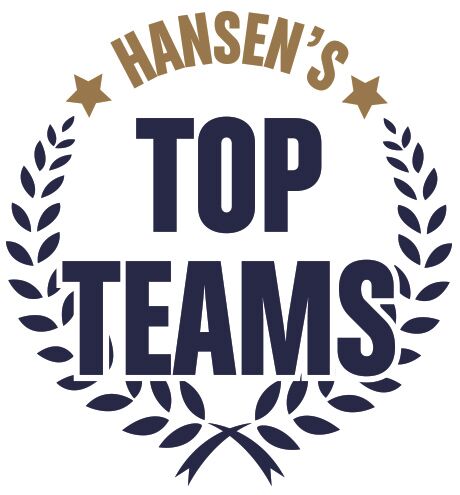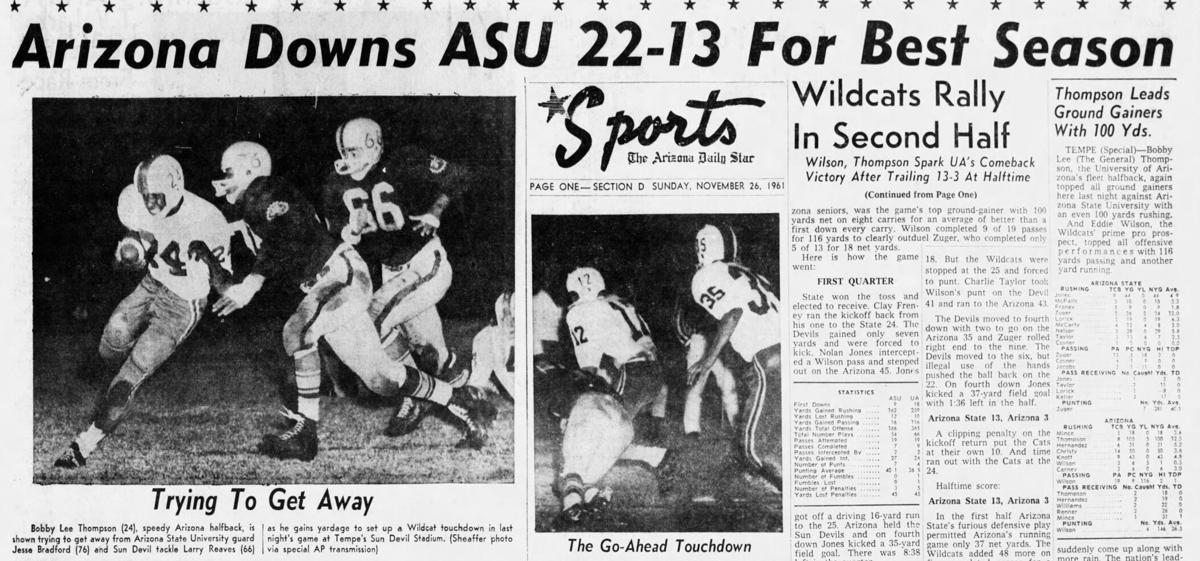If I could go back in a Tucson sports time machine, one of my first choices would be the 1961 Territorial Cup game at ASU.
A state-record crowd of 40,164 squeezed into ASU’s old stadium as the first nationally-ranked team in Arizona history — the 7-1-1 Wildcats were No.20 in the AP poll — played Frank Kush’s fearsome Sun Devils, who were 7-2.
ASU led 13-3 at half, shutting down the most celebrated backfield in UA history: quarterback Eddie Wilson, running back Bobby “The General” Thompson and Jackrabbit Joe Hernandez.
Three hours later, the Wildcats partied at a Tempe restaurant, eating steaks, smoking cigars and celebrating what to that point was the greatest football victory in UA history.
“Lordy, lordy,” said UA coach Jim LaRue, “that was the greatest comeback I ever saw.”
Arizona won 22-13 after Thompson ran 67 yards for a touchdown with 5:48 remaining, a historic burst from scrimmage through the ASU defense during which he appeared to be stopped three times.

I’ve been fortunate to watch Thompson’s 67-yard run on film several times and it ranks with any in UA history, a dramatic turn of events just when it seemed Kush’s Sun Devils would spoil Arizona’s rise from football perdition. Arizona had gone 1-8-1 in 1957 just as ASU rose to prominence under Kush and Dan Devine.
LaRue was often referred to as “Gentleman Jim.” He was soft-spoken, didn’t curse or yell at his players. His players carried him off the ASU turf that night in Tempe. When he was lowered to the ground, he told the Star’s Abe Chanin: “Brother, I am sure glad there are two halves to a football game.”
Arizona’s ’61 Wildcats were known locally as the “Cardiac Kids,” winning comebacks against Oregon, New Mexico, Wyoming and ASU. They also tied Nebraska, 14-14, in Lincoln, in Game 2, which led to a school-record attendance at Arizona Stadium, 24,255 per game.
A few years before LaRue died in 2015, I was fortunate to visit him at his home bordering a fairway at Forty Niner Country Club. He had retired from coaching in 1989, a career that began as an assistant coach at Maryland in the early 1940s and bounced to Kansas State, Houston, Arizona, Utah, Wake Forest and with the Buffalo Bills and Chicago Bears.
LaRue was the secondary coach for the epic 1985 Chicago Bears Super Bowl championship team, coached by Mike Ditka. LaRue worked under well-known defensive coordinator Buddy Ryan during a 15-1 regular season.
I asked LaRue how coaching the ’61 Wildcats compared to being on the staff of the ’85 Bears and, to my surprise, he went on and on about UA center Bob Garis, a center from Tucson High School, who played 60 minutes a game, never coming off the field.
“Bob never played a minute in the NFL,” said LaRue. “But when you coach a young man like him it’s a joy to be in the coaching business.”

UA’s win over ASU in 1961 gave the Wildcats an 8-1-1 record, the best mark in 62 years to that point.
That told me a lot about LaRue. It wasn’t about glamour. It was about getting the job done. It had been almost 50 years since Garis played for LaRue, but he chose to speak about him rather than the all-pro Bears like William “Refrigerator” Perry or Walter Payton or Mike Singletary.
The ’61 Wildcats deployed Garis-type players all over the field. Starting guard Howard Breinig, an undersized 5-foot-8-inch fireball from Pennsylvania, held his own against much bigger opponents from Nebraska, ASU and Oregon. (Breinig went on to coach Sahuaro High School to a 1994 state championship). So did Tucson High grad John Smull, a lineman who weighed 190 pounds.
LaRue recruited Wilson from Chandler, and his prized running backs Hernandez, from Bakersfield Junior College, and Thompson, from a junior college in Compton, California. All three played in the NFL.
Thompson remains one of the four greatest running backs in school history, with Trung Canidate, Art Luppino and Ka’Deem Carey. Wilson surely ranks as one of the UA’s three leading QBs, with Fred Enke and Nick Foles.
LaRue told me he regretted his exit from Arizona; he was forced to resign in 1967 after consecutive seasons of 3-7 and 3-7.

Nicknamed “Gentleman Jim,” former UA coach Jim LaRue went on to coach the Chicago Bears’ defensive backs during their 1985 Super Bowl season.
“We didn’t have any money in the athletic department, and it was difficult just to beat our WAC opponents like BYU, Utah and Wyoming,” he said. “But to raise more money, we scheduled Ohio State, Iowa, Missouri, Washington State and Oregon State, all teams who played at a higher level. It was rough.”
But it all worked out. LaRue showed me his 1985 Super Bowl ring but said he also cherished his days at Arizona.
“I’ve lived in Tucson for more than 30 years,” he said. “This is my home.”









